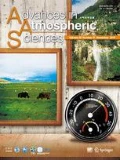Abstract
The global land monthly precipitation data (PREC/L) are used to investigate the relation between the global land annual precipitation and ENSO during 1948–2000, and the results of composite analysis are tested with Monte Carlo simulations. Results indicate that the global land annual precipitation was significantly reduced in large scale areas in warm event years; the areas were the equatorial West Pacific, North China; equatorial Central America; North Bengal Bay and Nepal; East Australia; West India and South Pakistan; the district east of the Lena River; West Europe; and Wilkes Land of Antarctica. In contrast to this, the areas where precipitation increased in warm event years were less, and mainly in Chile and Argentina of South America; Somali, Kenya, and Tanzania of East Africa; Turkey, Iraq, and Iran of the Middle East; Libya and Nigeria of North Africa; Namibia of Southwest Africa; and Botswana and Zimbabwe of southern Africa. Statistical tests show that in warm event years, the area where the land annual precipitation was reduced was larger than the area where the annual precipitation increased, and the reduction in precipitation was more significant than the increase. The results in this paper are compared with previous studies. It is also pointed out that the interdecadal change of ENSO had no significant effect on the interdecadal variation of precipitation in the above regions. However, the warm events of El Nino affected the droughts in East Australia and North China more after the 1980s than before.
Similar content being viewed by others
References
Bradley, R. S., H. F. Diaz, G. N. Kiladis, and J. K. Eischeid, 1987a: ENSO signal in continental temperature and precipitation records. Nature, 327, 497–500.
Bradley, R. S., H. F. Diaz, J. K. Eischeid, P. D. Jones, P. M. Kelly, C. M. Goodess, 1987b: Precipitation fluctuations over northern hemisphere land areas since the mid—19th century. Science, 237, 171–175.
Chen, M, P. Xie, J. E. Janowiak, P. A. Arkin, 2001: Global Land Precipitation : A 50-yr monthly analysis based on interpolation and reconstruction of gauge observations. 12th Symposium on Global Changes Studies and Climate Variations. Albuquerque, NM. 14-19 January.
Chen, M., P. Xie, J. E. Janowiak, P. A. Arkin, 2002: Global precipitation: a 50 year monthly analysis based on gauge observations. Journal of Hydrometeorology, 3(3), 249–266.
Hulme, M., 1992: A 1951-80 global land precipitation climatology for the evaluation of general circulation models. Climate Dynamics, 7, 57–72.
Lau, K. M., and P. J. Sheu, 1988: Annual cycle, quasi-biennial oscillation, and Southern Oscillation in global precipitation. J. Geophys. Res., 93, 10975–10988.
Lau, K. M., and P. J. Sheu, 1991: Teleconnection in global rainfall anomalies: Seasonal to interdecadal time scales. Teleconnections Linking Worldwide Climate Anomalies, edited by M. Glantz, R. Katz, and N. Nicholls, Cambridge University Press, Cambridge, U.K.
Li Qingquan, and Ding Yihui, 1997: The basic features of the El Nino events during 1991-1995 and their anomalous influences on the weather and climate in China. Climatic and Environmental Research, 2(2),163–178 (in Chinese).
Livezey, R. E., and W. Y. Chen, 1983: Statistical field significance and its determination by Monte Carlo techniques. Mon. Wea. Rev., 111,46–59.
Nicholson, S. E., B. Some, and B. Kone, 2000: An analysis of recent rainfall conditions in West Africa including the rainy seasons of the 1997 El Nino to 1998 La Nina years. J. Climate, 13, 2628–2640.
Noel, J., and D. Changnon, 1998:A pilot study examining U.S. winter cyclone frequency pattern associated with three ENSO parameters. J. Climate, 11, 2152–2159.
Rasmusson, E. M., and T. H. Carpenter, 1982: Variation in tropical sea surface temperature and surface wind field associated with the Southern Oscillation/El Niño.Mon. Wea. Rev., 110,345–384.
Ropelewsi, C. F., and M. S. Halpert, 1987:Global and regional scale precipitation patterns associated with El Niño/Southern Oscillation. Mon. Wea. Rev., 115, 1606–1626.
Trenberth, K. E., 1997: The definition of El Nino. Bull. Amer. Meteor. Soc, 78, 2771–1777.
Wang, B., 1994:Transition from a cold to awarm state of the El Nino-Southern Oscillation cycle. Met. Atmos. Phys., 48, 1–16.
Wang, B., 1995: Interdecadal change in El Nino onset in the last four decades. J. Climate, 8, 267–285.
Wang Shaowu, and Gong Daoyi, 1999:ENSO events and their intensity during the past century. Meteorological Monthly, 25(1), 9–14.
Xu Jianjun, and J. C. L. Chan, 2001: The role of the Asian-Australian monsoon system in the onset time of El Nino. J. Climate, 14, 418–433.
Author information
Authors and Affiliations
Rights and permissions
About this article
Cite this article
Neng, S., Luwen, C. & Dongdong, X. A preliminary study on the global land annual precipitation associated with ENSO during 1948–2000. Adv. Atmos. Sci. 19, 993–1003 (2002). https://doi.org/10.1007/s00376-002-0060-6
Received:
Revised:
Issue Date:
DOI: https://doi.org/10.1007/s00376-002-0060-6




